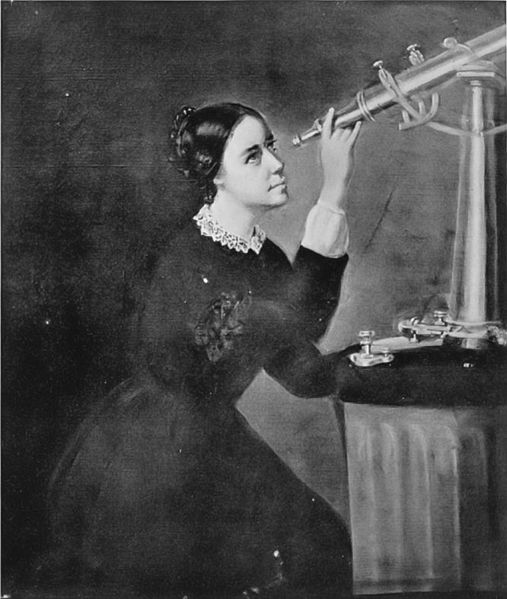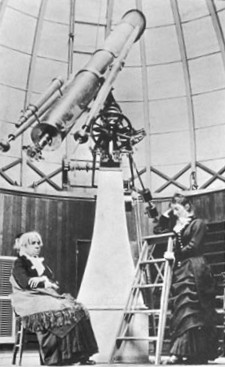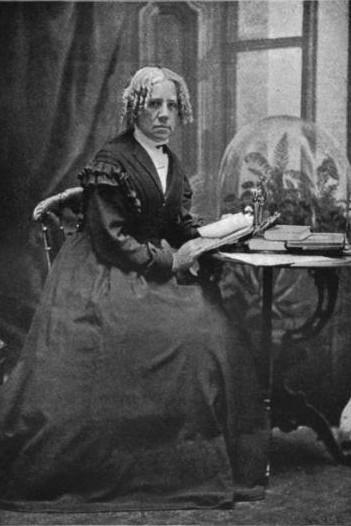<Back to Index>
- Astronomer Maria Mitchell, 1818
- Composer Benedetto Marcello, 1686
- King of the Hellenes Alexander, 1893
PAGE SPONSOR



Maria Mitchell (August 1, 1818 – June 28, 1889) was an American astronomer, who in 1847, by using a telescope, discovered a comet which as a result became known as the "Miss Mitchell's Comet". She won a gold medal prize for her discovery which was presented to her by King Frederick VII of Denmark. The medal said “Not in vain do we watch the setting and rising of the stars”. Mitchell was the first American woman to work as a professional astronomer.
One of ten children, she was raised in the Quaker religion. Maria Mitchell was born on August 1, 1818, in Nantucket, Massachusetts,
and was a first cousin of four removed of Benjamin Franklin. She had
nine brothers and sisters. Her parents, William Mitchell and Lydia
Coleman Mitchell, were Quakers.
Maria Mitchell was born into a community unusual for its time in regard
to equality for women. Her parents, like other Quakers, valued
education and insisted on giving her the same quality of education that
boys received. The Quaker religion taught, among other things,
intellectual equality between the sexes. Additionally, Nantucket's
importance as a whaling port meant that wives of sailors were left for
months and sometimes years to manage affairs while their husbands were
at sea, thus fostering an atmosphere of relative independence and
equality for the women who called the island home. In spite of this,
the women of Nantucket still lacked the right to own property or to
vote, among other things. After
attending Elizabeth Gardener's small school in her earliest childhood
years, Maria attended the North Grammar school, where William Mitchell
was the first principal. Two years following the founding of that
school, when Maria was eleven, her father built his own school on Howard
Street. There, she was a student and also a teaching assistant to her
father. At home, Maria's father taught her astronomy using his personal telescope. At age twelve and a half, she aided her father in calculating the exact moment of annular eclipse. Her father's school closed, and afterwards she attended Unitarian minister Cyrus Peirce's
school for young ladies. Later she worked for Peirce as his teaching
assistant before she opened her own school in 1835. One year later, she
was offered a job as the first librarian of the Nantucket Atheneum
where she worked for eighteen years. Using a telescope, she discovered the "Miss Mitchell's Comet" (Comet 1847 VI, modern designation is C/1847 T1) in the autumn of 1847. Some years previously, King Frederick VI of Denmark had established gold medal prizes to each discoverer of a "telescopic comet" (too faint to be seen with the naked eye).
The prize was to be awarded to the "first discoverer" of each such
comet (note that comets are often independently discovered by more than
one person). She duly won one of these prizes, and this gave her
worldwide fame, since the only previous woman to discover a comet had been Caroline Herschel. There was a temporary question of priority because Francesco de Vico had
independently discovered the same comet two days later, but had
reported it first; however, this was resolved in Mitchell's favor. The
prize was awarded in 1848 by the new king Frederick VII. She became the first woman member of the American Academy of Arts and Sciences in 1848 and of the American Association for the Advancement of Science in 1850. She later worked at the U.S. Nautical Almanac Office, calculating tables of positions of Venus, and traveled in Europe with Nathaniel Hawthorne and his family. She
became professor of astronomy at Vassar College in 1865, the first
person (male or female) appointed to the faculty. She was also named as
Director of the Vassar College Observatory.
After teaching there for some time, she learned that despite her
reputation and experience, her salary was less than that of many younger
male professors. She insisted on a salary increase, and got it.
In 1842, she left the Quaker faith and followed Unitarian principles. In protest against slavery, she stopped wearing clothes made of cotton. She was friends with various suffragists such as Elizabeth Cady Stanton and co-founded the American Association for the Advancement of Women. She was the first woman elected to the American Academy of Arts and Sciences and as one of the first women elected to the American Philosophical Society (1869, at this identical meeting Mary Fairfax Somerville and Elizabeth Cabot Carey Agassiz were also elected). She died on June 28, 1889, at the age of 70, in Lynn, Massachusetts. She was buried in Lot 411, Prospect Hill Cemetery, Nantucket. The Maria Mitchell Observatory in Nantucket is named in her honor. The Observatory is part of the Maria Mitchell Association in Nantucket,
which aims to preserve the sciences on the Island. It operates a
Natural History Museum, Maria Mitchell's Home Museum, and the Science
Library as well as the Observatory. She was also posthumously inducted
into the U.S. National Women's Hall of Fame. She was the namesake of a World War II Liberty ship, the SS Maria Mitchell. The crater Mitchell on the Moon is named after her. In 1902, the Maria Mitchell Association was founded in her memory. She
is also known for her famous quote, "We have a hunger of the mind. We
ask for all of the knowledge around us and the more we get, the more we desire." In 1905, Mitchell was inducted into the Hall of Fame for Great Americans in the Bronx, New York.